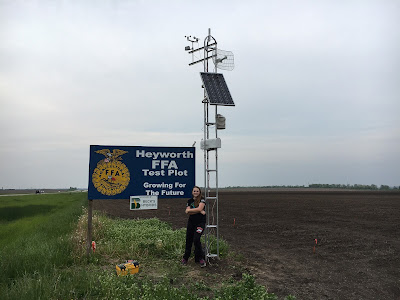 Ham Radio Mesh Networks – fun and fulfilling
Ham Radio Mesh Networks – fun and fulfilling
Two of the most rewarding aspects of ham radio for me are technical challenges and operational missions. My electrical engineering background has limited use in my day job as a technical leader for a Fortune 50 insurance and financial services company. Tactical missions (events, problems) are also not a part of my regular work as I focus on 6, 12, and 18 month strategies. I’m most content and excited when I can take my love of engineering and apply it to real missions in real life!
 |
| K9ECB – Erin – Using AREDN mesh to retrieve weather and soil data. |
For me, that’s what the Amateur Radio Emergency Data Network (AREDN) is all about. I’ve shared here before about using AREDN’s mesh software to provide access to our D-STAR repeaters. My daughter has also started usingAREDN to gather weather data from a home-brew Arduino weather station located in a corn field away from power and internet. Our local emergency management organization is considering a build-out of the mesh with remote pan-tilt-zoom cameras to be used for weather spotting. This use case provides us the ability to watch approaching storms from the EOC to confirm and augment our spotter teams. And hams in Southern California are working with emergency management teams to provide live video and audio of events.
The concept is to take commercial off-the-shelf (COTS) technology and re-purpose it into a mesh data network. Unlike my early days of playing with 1200 baud packet on the AMPRNet 44.x network, AREDN is using 2.4, 3, and 5GHz ham allocations with TP-Link and Ubiquiti gear to provide a mesh network with speeds over 100 Mbps.
 |
| An omni and point to point AREDN 5GHz mesh site feeding a D-STAR repeater. |
For some parts of our hobby, the barrier to entry is price. That’s not the case for AREDN. For under $100 you can have a working node. With some careful purchases from eBay and some bargains from online retailers you can have a fully functioning mesh of 3 nodes for under $200.
When I play with HF, I never know who I’m going to find, what mode I’ll end up using, or if I’ll have a ragchew or a short contact. Mesh networking isn’t like that. It isn’t even like VHF/UHF repeaters. “Meshing” is about setting up some base infrastructure in an area and then using it for specific purposes (like my D-STAR repeater or weather spotting example) or preparing for on-demand deployments (like the Southern California local emergency management use case). There are groups in Tennessee doing large exercises passing incident command system (ICS) messages via Winlink that is self-sustaining on an AREDN mesh. There are those using Raspberry pi voice over IP gateway and IP phones to provide communication between tactical and command teams. And there’s even a group with an HF radio controlled across the mesh providing long distance off-internet communications using an existing station rather than doing a field-day like setup at a command post.
The core AREDN development team is made up of six volunteers. Because the software is open sourced, other assist, modify and customize to meet their needs. Depending on your level of interest, you can code and hack away or you can install the software and just stay in the graphical interface. It’s more than working with computers, as understanding microwave antennas and limitations are important for a successful implementation. Sure, you can plug-and-play two nodes in a hamfest parking lot and have a mesh. The real challenge comes when you want to build a data backbone between multiple sites and provide reliable service to your mission!
There are over 600 hams that have connected and registered on the AREDN.org website to interact with other hams wanting to do similar things. Thousands more have downloaded the software. The AREDN just released version 3.16.1.0 of the firmware bringing with it support for new devices, faster throughput, real-time stats, and other operational management features. More impressive is that the team released a substantial upgrade in December. This team, with help from beta testers and early adopters is on pace to have two major releases each year.
The amateur radio community is quite diverse, both in people and technologies. I’ve thoroughly enjoyed experimenting with AREDN and with using it for a mission. If your local ham community is interested in a new challenge, especially if you’re looking for a way to get the next generation of hams involved, consider getting involved with mesh networking and AREDN.













